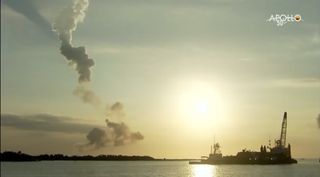NASA's next crew-carrying spaceship just took a big step toward operational flight.
The Orion capsule aced a critical launch-abort test this morning (July 2), showing that it can indeed get astronauts out of harm's way during a liftoff emergency and keeping the craft on target for a first crewed flight in 2022.
"It looked beautiful from here," Ashley Tarpley, NASA's range flight safety lead for today's test, said during a NASA broadcast of the procedure. "I think that was excellent, we could not have hoped for a better kind of day. It's just wonderful."
A test version of Orion launched at 7 a.m. EDT (1100 GMT) from Florida's Cape Canaveral Air Force Station, taking to the skies atop the refurbished first-stage motor of a Peacekeeper intercontinental ballistic missile. Fifty-two seconds later, at an altitude of about 31,000 feet (9,450 meters), the launch abort system (LAS) attached to the top of the capsule kicked into gear.
Related: Orion Explained: NASA's Multi-Purpose Crew Vehicle (Infographic)
The LAS' abort motor fired, its 400,000 lbs. of thrust pulling Orion up and away from the booster and imparting about 7 Gs of force in the process. (We feel 1 G continuously on Earth's surface, thanks to our planet's gravitational pull.) At the time, Orion was projected to be moving at about 800 mph (1,300 km/h) and experiencing extreme temperatures and pressures, NASA officials said.
Just over 80 seconds into flight, at an altitude of about 44,000 feet (13,400 m), the LAS tower separated and Orion began flying freely — and soon began descending.
Everything was over by about 3 minutes after liftoff, when the capsule slammed hard into the Atlantic at roughly 300 mph (500 km/h), 7 miles (11 km) off the Florida coast. Orion likely broke apart upon impact and sank to the ocean floor, NASA officials said.
This fate was expected, because the capsule flew today without parachutes or an attitude-control system (which it will have during crew-carrying flights).
The project team went with this stripped-down approach "in order to perform this test as early as possible, because we want to get the data," Orion program manager Mark Kirasich said during a prelaunch press conference on Monday (July 1), referring to measurements of temperature, pressure and other variables made by 900 sensors flying aboard the capsule today.
"We want to inform the missions going forward," he added.
Those future missions include Artemis 1, the first flight of Orion and its partner rocket, NASA's huge Space Launch System (SLS), which is still in development. Artemis 1, targeted for launch next summer, will send an uncrewed Orion on a journey around the moon. That will be the first mission for the powerful and long-awaited SLS.
Artemis 2, the first crewed flight of the system, will follow in 2022, if all goes according to plan. This lunar flyby mission will mark the first trip astronauts have made beyond Earth orbit since the Apollo moon program ended in 1972.
Artemis is NASA's ambitious lunar-exploration program, which aims to land astronauts near the moon's south pole by 2024 and build up a long-term, sustainable presence on and around Earth's nearest neighbor in the ensuing years. Such work is envisioned to help prepare humanity to make the next giant leap — a crewed mission to Mars, which NASA aims to achieve in the 2030s.
Today's test flight is officially known as Ascent Abort-2. As that name suggests, it was the second trial for Orion's launch-escape system. The first one occurred in May 2010, when Orion's LAS lifted a test capsule off the ground in a pad abort test.

The scene at Port Canaveral in Florida after NASA's test of the Orion capsule's launch abort system.
(Image credit: NASA TV)
Escape systems are common safety features of crew-carrying spaceships. For example, Russia's Soyuz spacecraft is topped with a similar "puller" tower. This emergency equipment was pressed into service last October during a crewed launch to the International Space Station — the first time an LAS had been employed during an operational mission since another Soyuz launch in 1983. (NASA's now-retired space shuttle orbiter did not have an LAS, so the crew of the Challenger had no way to get clear of their malfunctioning solid rocket booster shortly after launch in January 1986.)
The two crew capsules in development by American companies, Boeing's CST-100 Starliner and SpaceX's Crew Dragon, have abort thrusters built into their bodies. Such a design is known as a "pusher" system, because the craft pushes itself to safety rather than being pulled by tower-mounted motors.
Mike Wall's book about the search for alien life, "Out There" (Grand Central Publishing, 2018; illustrated by Karl Tate), is out now. Follow him on Twitter @michaeldwall. Follow us on Twitter @Spacedotcom or Facebook.
https://www.space.com/nasa-orion-capsule-abort-test-flight.html
2019-07-02 11:18:00Z
52780324298005
Bagikan Berita Ini














0 Response to "NASA's Orion Crew Capsule Aces Big Safety Test - Space.com"
Post a Comment